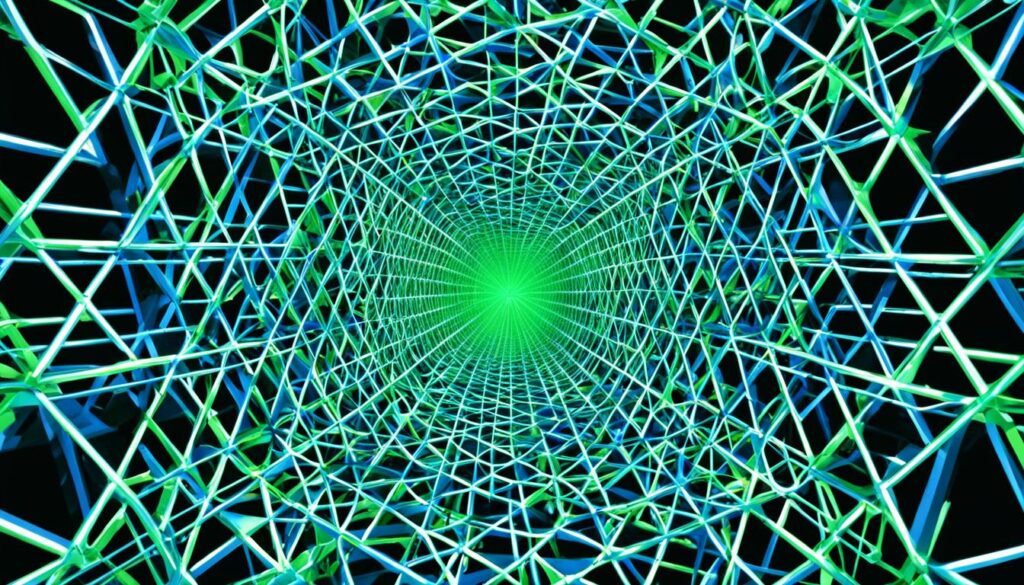The digital age has changed how we talk, do business, and keep things safe online. But, it has also brought a big threat: quantum computing. These computers can do calculations way faster than our current ones, which could break the security systems we use now.
As we move closer to having quantum computers, we need new ways to keep our data safe. That’s where post-quantum cryptography comes in. It uses advanced math to make new kinds of encryption that can fight off quantum threats. This includes things like lattice-based, code-based, multivariate, and isogeny-based cryptography.
This article talks about how post-quantum cryptography is key to keeping our online world safe. We’ll look into how quantum computing threatens our current security, the new ways to encrypt data, and how technologies like quantum key distribution help keep our digital world secure.
Table of Contents
ToggleKey Takeaways
- Post-quantum cryptography is crucial for securing digital communications against the threat of quantum computing.
- Quantum computers pose a significant challenge to classical cryptographic systems, highlighting the need for quantum-resistant algorithms.
- Post-quantum cryptographic techniques, including lattice-based, code-based, multivariate, and isogeny-based cryptography, offer promising solutions to this challenge.
- Quantum key distribution and quantum random number generation are complementary technologies that enhance the security of cryptographic systems.
- Ongoing research and development in post-quantum cryptography are critical to ensuring the long-term security of our digital future.
Quantum Computing and the Cryptographic Challenge
In today’s digital world, cryptography is key to keeping our online activities safe. But, Quantum Computing is now a big threat to the old ways of keeping data secure.
The Threat to Classical Cryptography
Old cryptographic methods like RSA and Elliptic Curve Cryptography depend on solving hard math problems. Quantum computers can solve these problems much faster, putting our data at risk.
This is a big deal because it could break the security of many important systems. We need new, quantum-safe ways to protect our data fast.
The Need for Quantum-Resistant Algorithms
- Creating Quantum-Resistant Algorithms is key to keeping our digital world safe from quantum threats.
- These algorithms must be strong against quantum computers’ unique powers.
- Experts are working hard to find and test the best Quantum-Resistant Algorithms.
The push to make our digital security stronger is more urgent than ever. If Quantum Computing can break our old cryptography, it will change how we trust our online activities.
Post-Quantum Cryptography: An Overview
The era of quantum computing is coming fast, making Post-Quantum Cryptography more urgent. This field aims to create Quantum-Resistant Algorithms. These algorithms can protect against the threats of powerful quantum computers. Such computers could break the encryption we use today easily.
Post-Quantum Cryptography includes Lattice-Based Cryptography. These algorithms use the complexity of lattice problems to stay safe against attacks. Code-Based Cryptography is also promising. It uses the complexity of error-correcting codes for security.
Multivariate Cryptography focuses on solving systems of complex equations. Isogeny-Based Cryptography uses elliptic curve isogenies for secure algorithms.
Hash-Based Signatures are a reliable way to sign digital messages. They are quantum-resistant and don’t need complex math.
Researchers and cryptographers are exploring these quantum-resistant algorithms. They aim to keep our digital communications safe from the quantum computing threat.
Lattice-Based Cryptography
The threat of quantum computing is real, making the need for quantum-resistant algorithms urgent. Lattice-based cryptography is a key solution being explored. It’s gaining a lot of attention lately.
Understanding Lattice-Based Algorithms
Lattice-based algorithms use complex problems related to lattices to keep data safe. They’re thought to be safe against quantum computer attacks. These lattice-based algorithms turn data into points in a high-dimensional lattice. Then, they make it hard to break these lattices, even for quantum computers.
This method is flexible. It can create many types of secure tools, like public-key encryption and digital signatures. These are vital for keeping online communication and data safe.
| Lattice-Based Cryptography | Quantum-Resistant Algorithms | Lattice-Based Algorithms |
|---|---|---|
| A promising approach to post-quantum cryptography | Crucial for securing digital communications in the face of quantum computing threats | Rely on the computational complexity of solving lattice-related problems |
| Offers flexibility in creating cryptographic primitives | Can be used for public-key encryption, digital signatures, and key exchange | Believed to be resistant to attacks from quantum computers |
As we move more into the digital world, we need strong, secure ways to protect our data. Lattice-based cryptography is a key solution. It offers a way to keep our digital information safe from quantum threats.

Code-Based Cryptography
In the world of post-quantum cryptography, code-based cryptography is a key player. It offers strong ways to protect digital messages. This type of cryptography uses error-correcting codes, like the McEliece cryptosystem, for quantum-safe security.
The McEliece cryptosystem was created by Robert J. McEliece. It’s a public-key algorithm that uses algebraic codes to fight quantum threats. This system is hard to crack because of its complex decoding, making it a strong defense against quantum attacks.
Code-based cryptography is different from old methods that depend on solving hard math problems. It uses the difficulty of decoding linear codes. This makes it hard for even the most powerful quantum computers to break, making it crucial in the post-quantum world.
| Algorithm | Underlying Principle | Key Advantages |
|---|---|---|
| McEliece Cryptosystem | Decoding of linear error-correcting codes | Quantum-resistant, efficient encryption, and decryption |
| Niederreiter Cryptosystem | Decoding of linear error-correcting codes | Smaller public key size compared to McEliece, efficient decryption |
| NTRU | Lattice-based cryptography with error-correcting codes | Fast encryption and decryption, smaller key sizes |
As technology changes, Code-Based Cryptography becomes more important. It helps keep our digital messages safe, even with the rise of quantum computing.
Multivariate Cryptography
Multivariate cryptography is a key area in making cryptography quantum-proof. It uses the hard math of solving many polynomial equations at once. This method is thought to be safe against quantum computer attacks.
The Complexity of Multivariate Equations
The strength of multivariate cryptography comes from solving hard polynomial equations. This is an NP-hard problem, meaning it gets much harder as the equations get more complex. Even the fastest computers struggle with it.
This type of cryptography uses this math to make secure keys. These keys protect data from both old and new threats. By using special polynomial systems, experts have made Multivariate Cryptography algorithms. These algorithms are Quantum-Resistant Algorithms for keeping online info safe.
“The security of multivariate cryptography relies on the inherent difficulty of solving systems of Multivariate Equations, a problem that is believed to be resistant to quantum computing attacks.”
Multivariate cryptography is flexible and can meet various security needs. Researchers are always finding new ways to improve it. This makes it a strong choice for protecting our digital world.
Isogeny-Based Cryptography
Isogeny-Based Cryptography is a new way to protect our digital world from threats. It uses the complex math of elliptic curve isogenies. This makes algorithms that can fight off powerful quantum computers.
Elliptic Curve Isogenies and Security
Elliptic curve isogenies change one elliptic curve into another while keeping key properties the same. This is key to Isogeny-Based Cryptography. The hard part of computing these isogenies makes it secure.
This method is different from old ways that use big numbers or solving problems. Isogeny-Based Cryptography is safe against quantum computers. Finding these isogenies is hard, even for quantum computers, making it a strong choice for the future.
“Isogeny-Based Cryptography harnesses the power of elliptic curve isogenies to create a new frontier in post-quantum security.”
Isogeny-Based Cryptography uses the math of elliptic curves to protect our digital world. It’s a strong and flexible way to keep our digital info safe from quantum threats. As we move forward, this method shows how smart people are making our digital world stronger.

Hash-Based Signatures
Hash-based signatures are a key part of post-quantum cryptography. They help keep digital communications safe from quantum computers. These algorithms use strong cryptographic hash functions. This makes them a good choice for digital signatures against future quantum threats.
Hash-based signatures have many benefits. They are quick and efficient, unlike some other post-quantum methods. They also use simple, well-known parts. Plus, they are smaller, which is great for many uses, like secure messages and IoT device signatures.
- Hash-based signatures use the strength of cryptographic hash functions, which are thought to be safe against quantum attacks.
- These algorithms offer a flexible and efficient way for digital signatures. They could soon replace RSA and ECDSA in a post-quantum world.
- Because they are small and fast, hash-based signatures are perfect for many situations. This includes secure messaging and managing digital identities.
The threat of quantum computing is real, making us need quantum-resistant cryptography more than ever. Hash-based signatures are a crucial part of this solution. They provide a dependable and easy way to protect digital transactions and messages in the future.
“Hash-based signatures are a fundamental building block of post-quantum cryptography, providing a scalable and efficient solution for securing digital communications against the threat of quantum computers.”
Post-Quantum Cryptography and Quantum Key Distribution
As quantum computing becomes a bigger threat, companies are looking at post-quantum cryptography and quantum key distribution (QKD). These methods work together to keep digital data safe from quantum attacks.
Post-quantum cryptography is about making new, quantum-proof algorithms. Quantum key distribution uses quantum mechanics to make sure messages are safe. If someone tries to listen in, it will be caught right away.
Using both methods together gives a strong defense against quantum-computing threats. Post-quantum cryptography keeps data safe with quantum-resistant algorithms. QKD makes sure the keys for encryption are sent safely, adding more security.
Quantum Xchange’s Phio Trusted Xchange is a system that makes sure data is safe. It works with QKD and helps companies and governments stay secure. This system fits well with current IT setups, making it easier to move to a quantum-safe future.
| Approach | Description | Advantages |
|---|---|---|
| Post-Quantum Cryptography | Developing algorithms resistant to quantum computing attacks | Protects data from quantum-powered decryption |
| Quantum Key Distribution (QKD) | Leveraging quantum mechanics to establish secure communication channels | Ensures the secure distribution of cryptographic keys |
By using post-quantum cryptography and quantum key distribution together, companies can make their digital security stronger. This helps them stay safe from the dangers of quantum computing.
“The combination of post-quantum cryptography and quantum key distribution creates a powerful security solution that can withstand the challenges posed by quantum computing.”
Quantum Random Number Generation
In the world of post-quantum cryptography, true randomness is key. Cryptographic algorithms need random numbers to keep digital communications safe and secure. Traditional methods like free-running oscillators (FROs) have limits. This is where quantum random number generation (QRNG) changes the game.
True Randomness for Cryptographic Applications
Quantum systems naturally produce randomness, making them perfect for true random number generation. This is different from classical systems, which can be predictable. QRNG uses this quantum randomness to create truly random numbers. These are vital for strong post-quantum cryptography.
Adding QRNG to post-quantum cryptography makes it stronger against quantum attacks. It ensures digital communications stay confidential and secure. This keeps our cryptographic systems safe for the future.
| Characteristic | Traditional Hardware-based RNG | Quantum Random Number Generator |
|---|---|---|
| Randomness | Limited and potentially biased | True, provable randomness from quantum phenomena |
| Predictability | Can be susceptible to prediction and manipulation | Inherently unpredictable due to quantum uncertainty |
| Security | Vulnerable to classical attacks | Robust against both classical and quantum attacks |
Quantum random number generation is a big step forward for cryptography. It brings new security and resilience as we face the quantum computing era. QRNG will be key in protecting our digital world as we move forward.
“Quantum random number generators are a fundamental building block of post-quantum cryptography, ensuring the generation of truly random, unpredictable numbers that are essential for secure communications in the age of quantum computing.”
Challenges and Future Directions
The field of post-quantum cryptography is growing fast. Researchers and leaders in the industry face many challenges. They need to develop, standardize, and use quantum-resistant algorithms. Working together across different sectors is key to making this transition smooth.
One big challenge is finding and improving post-quantum cryptographic algorithms. Researchers are looking into different types like lattice-based, code-based, and isogeny-based cryptography. They aim to make these solutions strong, fast, and easy to use.
Another challenge is making sure these new algorithms are widely accepted. Groups like the National Institute of Standards and Technology (NIST) play a big role. They help set standards for these algorithms. This makes sure everything works together well and gives a clear plan for moving to new security measures.
FAQ
What is post-quantum cryptography?
Post-quantum cryptography is about making algorithms that can’t be broken by quantum computers. These algorithms are made to keep digital messages safe even when quantum computers are used to try to break them.
What are the main types of post-quantum cryptographic algorithms?
There are several types of post-quantum algorithms. These include lattice-based, code-based, multivariate, isogeny-based, and hash-based signatures. Each type uses different math and computing ideas to stay safe from quantum threats.
How does lattice-based cryptography work?
Lattice-based cryptography uses hard math problems related to lattices. These problems are hard for quantum computers to solve. Algorithms like Ring-LWE and Module-LWE are examples of this type and are good against quantum threats.
What is the significance of code-based cryptography?
Code-based cryptography uses the hard problem of decoding certain codes for security. The McEliece system is a key example. It uses error-correcting codes to fight off quantum attacks.
How does multivariate cryptography achieve quantum resistance?
Multivariate cryptography tackles complex systems of polynomial equations. These equations are hard for quantum computers to solve. This makes multivariate cryptography a strong way to keep data safe in the quantum age.
What is the role of isogeny-based cryptography in post-quantum cryptography?
Isogeny-based cryptography uses the math of elliptic curve isogenies for security. It’s tough for quantum computers to solve these math problems. This makes it a strong choice for keeping data safe in the quantum world.
How do hash-based signatures contribute to post-quantum cryptography?
Hash-based signatures use special hash functions that quantum computers can’t easily break. Schemes like Lamport and Merkle signatures are examples. They’re versatile and secure for many digital signature needs.
What is the relationship between post-quantum cryptography and quantum key distribution?
Post-quantum cryptography and quantum key distribution (QKD) work together to secure digital info in the quantum era. Post-quantum cryptography makes algorithms that resist quantum threats. QKD uses quantum mechanics to create secure communication lines, making digital systems even safer.
Why is quantum random number generation important for post-quantum cryptography?
Quantum random number generation (QRNG) gives true randomness, which is key for secure crypto algorithms. QRNG uses quantum mechanics to ensure randomness, making post-quantum crypto systems more reliable and secure.
What are the key challenges and future directions in post-quantum cryptography?
The big challenges include making standards, finding efficient algorithms, and getting them into use. The future might bring better algorithms, new quantum-resistant methods, and easier integration into digital systems.













